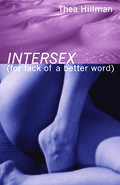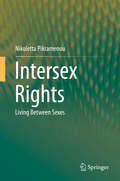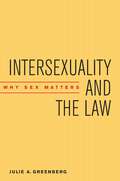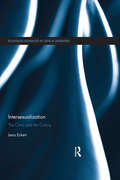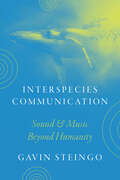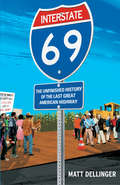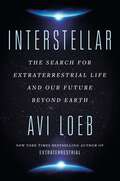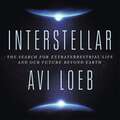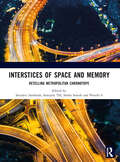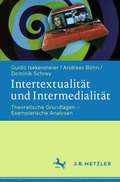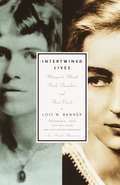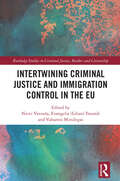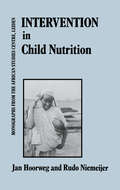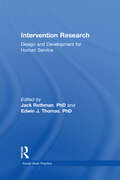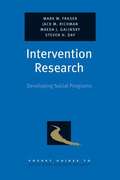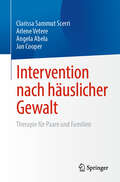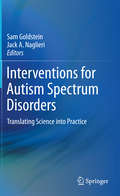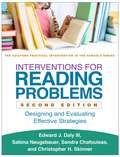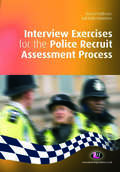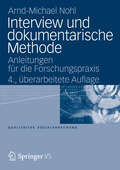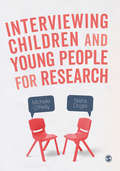- Table View
- List View
Intersex (For Lack of a Better Word)
by Thea Hillman"In Hillman's world, the surer you become about who you are, the more vulnerable you get."--The San Francisco Bay Guardian "Hillman's writing is sexy because it's smart and refuses to simplify things."--Fabula Magazine "Hillman's utterly unabashed memoir...showcases both the personal, embodied realities of intersex, and the social and political milieus that shape them... Intersex, too, is gorgeously written."--Women's Review of Books "It's utterly impossible to not be spellbound by performer-activist Thea Hillman, in person or in print ... A must-read."--Curve "There's nothing else in print like this amazing and courageous book."--Patrick Califia, author of Sex Changes: The Politics of Transgenderism "An important and wonderfully disarming book. Poetic, political, and deeply personal."--Beth Lisick, author of Helping Me Help Myself Intersex (For Lack of a Better Word) chronicles one person's search for self in a world obsessed with normal. What is "intersex"? According to the Intersex Society of North America, the word describes someone born with sex chromosomes, genitalia, or an internal reproductive system that are neither clearly male nor clearly female. In first-person prose as intimate as a diary, Thea Hillman redefines memoir in a series of compelling stories that take a no-holds-barred look at sex, gender, family, and community. Whether she's pondering quirky family tendencies ("Drag"), reflecting on "queerness" ("Another"), or recounting scintillating adventures in San Francisco's sex clubs, Hillman's brave and fierce vision for cultural and societal change shines through.
Intersex Matters: Biomedical Embodiment, Gender Regulation, and Transnational Activism (SUNY series in Queer Politics and Cultures)
by David A. RubinIntersex Matters analyzes the medicalization of people diagnosed as "intersex," which is an umbrella term for individuals born with sexual anatomies various societies deem to be nonstandard. Through an examination of medico-scientific, scholarly, political, and popular archives from the mid-twentieth century to the present, Rubin argues that the medical regulation of atypical sex is fundamentally a feminist and a queer issue, and an intersectional and transnational one as well. Critical attention to intersex lives, bodies, narratives, and activisms profoundly reconfigures contemporary paradigms of sex/gender, race, health, normality, biopolitics, and human rights. Rubin charts the emergence of intersex rights activism in the global north and global south, thus demonstrating the value of understanding intersex experience when rethinking the vicissitudes of body politics in a globally interconnected world.
Intersex Rights: Living Between Sexes
by Nikoletta PikramenouThis book addresses intersex rights violations and analyses intersex people’s legal demands as expressed by intersex activists themselves and delivered through statements and reports issued by intersex rights organisations, the United Nations and the Council of Europe. Intersex people are born with sex characteristics that do not fit typical notions of male or female bodies, as a result of which they are stigmatised, marginalised and denied the recognition of their fundamental rights. Often, they are subjected to involuntary and harmful sex “normalising” surgeries at birth, which violate their bodily integrity, self-determination and informed consent, so as to comply with societal and legal norms.Moreover, binary legal frameworks prevent them from enjoying the rights to access identification documents, start a family, or be free from discrimination in all areas including employment and sports. To elaborate on intersex violations that emanate from binary laws, this book examines the situation of intersex rights in regional jurisdictions worldwide and within the European Union in particular. In the process, it identifies current legal barriers and suggests how intersex people could be accommodated under legal frameworks and achieve sex/gender equality beyond binary definitions.
Intersexuality and the Law: Why Sex Matters
by Julie A. GreenbergWinner of the 2013 Bullough Award presented by the Foundation for the Scientific Study of Sexuality The term “intersex” evokes diverse images, typically of people who are both male and female or neither male nor female. Neither vision is accurate. The millions of people with an intersex condition, or DSD (disorder of sex development), are men or women whose sex chromosomes, gonads, or sex anatomy do not fit clearly into the male/female binary norm. Until recently, intersex conditions were shrouded in shame and secrecy: many adults were unaware that they had been born with an intersex condition and those who did know were advised to hide the truth. Current medical protocols and societal treatment of people with an intersex condition are based upon false stereotypes about sex, gender, sexual orientation, gender identity, and disability, which create unique challenges to framing effective legal claims and building a strong cohesive movement. In Intersexuality and the Law, Julie A. Greenberg examines the role that legal institutions can play in protecting the rights of people with an intersex condition. She also explores the relationship between the intersex movement and other social justice movements that have effectively utilized legal strategies to challenge similar discriminatory practices. She discusses the feasibility of forming effective alliances and developing mutually beneficial legal arguments with feminists, LGBT organizations, and disability rights advocates to eradicate the discrimination suffered by these marginalized groups.
Intersexualization: The Clinic and the Colony (Routledge Advances in Critical Diversities)
by Lena EckertSince the 1970s, research into ‘Intersex’ has been a central fascination for feminist theorists seeking to make arguments about how men and women are created as social/gender categories. Intersexualization: The Clinic and the Colony takes the case of Olympic runner Caster Semenya as a starting point to explore the issue of determining sex, and the ways in which intersexuality is a ‘threat’ to the distinction between men/women, homosexuality/heterosexuality and white/black. By focusing on the 1950s and the 40 years after, Eckert shows how what she calls intersexualization began in psycho-medical research at the Johns Hopkins Hospital in Baltimore and UCLA, and has from there spread into cross-cultural anthropological accounts conducted in Papua New Guinea and the Dominican Republic. With cross-cultural intersexualization having been largely neglected in recent literature on intersex, this timely volume describes how such intersexualization derives from the combination of medicalization and pathologization through two crucial parts. The first part, “The Clinic,” describes historical psycho-medical material engaging with hermaphroditism ranging from Greek Mythology up to today. This is followed by “The Colony,” which analyzes, in several close-readings, cross-cultural anthropological, sexological and psychoanalytical accounts contributing to cross-cultural intersexualization. Enclosing a wide range of inter- and transdisciplinary approaches to heteronormative and dichotomously organized frames of knowledge and organization, this volume is essential reading for upper-undergraduate and post-graduate students within the fields of gender studies, social studies of medicine, anthropology,science and technology studies, cultural studies, sociology, and history of medicine.
Interspecies Communication: Sound and Music beyond Humanity
by Gavin SteingoA surprising study reveals a plethora of attempts to communicate with non-humans in the modern era. In Interspecies Communication, music scholar Gavin Steingo examines significant cases of attempted communication beyond the human—cases in which the dualistic relationship of human to non-human is dramatically challenged. From singing whales to Sun Ra to searching for alien life, Steingo charts the many ways we have attempted to think about, and indeed to reach, beings that are very unlike ourselves. Steingo focuses on the second half of the twentieth century, when scientists developed new ways of listening to oceans and cosmic space—two realms previously inaccessible to the senses and to empirical investigation. As quintessential frontiers of the postwar period, the outer space of the cosmos and the inner space of oceans were conceptualized as parallel realities, laid bare by newly technologized “ears.” Deeply engaging, Interspecies Communication explores our attempts to cross the border between the human and non-human, to connect with non-humans in the depths of the oceans, the far reaches of the universe, or right under our own noses.
Interstate 69: The Unfinished History of the Last Great American Highway
by Matt Dellinger"New Yorker" contributor and decade-long staffer Dellinger uses the controversy surrounding Interstate 69 as a lens through which to examine middle America's current political, social, and economic landscape.
Interstellar: The Search for Extraterrestrial Life and Our Future Beyond Earth
by Avi Loeb'LOEB IS AN ASTRONOMICAL SHERLOCK HOLMES' Washington Post'A JOY IN CONJECTURE AND AN OMNIVOROUS SPIRIT OF INQUIRY. . . CARL SAGAN WOULD HAVE LIKED THIS BOOK' The Times In 2017, Avi Loeb, Chair of Harvard's Astronomy Department, went public with a theory that shook the scientific community - our solar system has been visited by advanced alien technology. His provocative and persuasive argument (and internationally bestselling book Extraterrestrial) has opened thousands of minds to the existence of intelligent life beyond Earth. This book tackles the huge question of what happens next?Long the stuff of science-fiction, here at last is the science fact. From advances in deep space probes to ongoing searches for extraterrestrial technology in our night sky, through the latest heated debates over the existence of Unidentified Aerial Phenomena, Interstellar offers a thrilling, front-row view of the technology and the ideas currently preparing us for contact with alien civilizations. Providing the first realistic and practical blueprint for how that might actually occur, Professor Loeb lays out the profound implications of our becoming - or not becoming - an interstellar species. In an urgent, eloquent appeal for more proactive engagement with the outer universe, he powerfully contends why we must seek out other life forms, and in the process, choose who and what we are within the universe.Combining cutting-edge science, physics, and philosophy, Loeb takes us on a mind-bending journey through the furthest reaches of science, space-time, and the human imagination. Interstellar is an eye-opening, necessary look at our future that proves, once again, that scientific curiosity offers the key to our survival.'Loeb is surely correct. . . scientists studying the vastness of the cosmos should entertain risky ideas more often, for the universe is undoubtedly more wild and unexpected than any extremes conjured by the human imagination' Economist'A COMPELLING ARGUMENT FOR A MORE OPEN-MINDED APPROACH TO SCIENCE - A COMBINATION OF HUMILITY AND WONDER' New Statesman
Interstellar: The Search for Extraterrestrial Life and Our Future Beyond Earth (Father Anselm Novels #14)
by Avi Loeb'LOEB IS AN ASTRONOMICAL SHERLOCK HOLMES' Washington Post'A JOY IN CONJECTURE AND AN OMNIVOROUS SPIRIT OF INQUIRY. . . CARL SAGAN WOULD HAVE LIKED THIS BOOK' The TimesFrom the iconoclastic Harvard astronomer and New York Times best-selling author of Extraterrestrial, an urgent explanation of why becoming an interstellar species is imperative for humanity's survival - and a game plan for how we can settle among the stars. In 2017, Avi Loeb, Chair of Harvard's Astronomy Department, went public with a theory that shook the scientific community - our solar system has been visited by advanced alien technology. His provocative and persuasive argument (and internationally bestselling book Extraterrestrial) has opened thousands of minds to the existence of intelligent life beyond Earth. This book tackles the huge question of what happens next?Long the stuff of science-fiction, here at last is the science fact. From advances in deep space probes to ongoing searches for extraterrestrial technology in our night sky, through the latest heated debates over the existence of Unidentified Aerial Phenomena, Interstellar offers a thrilling, front-row view of the technology and the ideas currently preparing us for contact with alien civilizations. Providing the first realistic and practical blueprint for how that might actually occur, Professor Loeb lays out the profound implications of our becoming - or not becoming - an interstellar species. In an urgent, eloquent appeal for more proactive engagement with the outer universe, he powerfully contends why we must seek out other life forms, and in the process, choose who and what we are within the universe.Combining cutting-edge science, physics, and philosophy, Loeb takes us on a mind-bending journey through the furthest reaches of science, space-time, and the human imagination. Interstellar is an eye-opening, necessary look at our future that proves, once again, that scientific curiosity offers the key to our survival.'Loeb is surely correct. . . scientists studying the vastness of the cosmos should entertain risky ideas more often, for the universe is undoubtedly more wild and unexpected than any extremes conjured by the human imagination' Economist'A COMPELLING ARGUMENT FOR A MORE OPEN-MINDED APPROACH TO SCIENCE - A COMBINATION OF HUMILITY AND WONDER' New Statesman(P) 2023 HarperCollins
Interstices of Space and Memory
by Dr Sreedevi Santhosh Dr Samjaila Th Dr Sneha Suresh Preethi SThe conference intersectionally locates memory and space that reconstruct city chronotopes to explore how identities are reconfigured in metropolitan Indian cities. In taking recourse in locating turning points that could be historical, political or cultural in the life of ‘Metropolitan Indian Cities’ the perspective that is brought together with personal and collective stories that are recorded in Art /Literature /Curated Projects /Museums is that these moments reshape human values/ ethos in Cities. The assumption made is that at specific moments in time / turning points, with the pandemic for instance the spirit of the city changes. It highlights how human beings in cities account for such changes (the IIHS runs a postcard project on human lives during the plague and corona) being an example. It uses focal moments in the City as the lens to discuss Art, Literature and City Design.
Intertextualität und Intermedialität: Theoretische Grundlagen – Exemplarische Analysen
by Guido Isekenmeier Andreas Böhn Dominik SchreyDieser Band bietet eine Einführung in theoretische Grundlagen und zentrale Aspekte der Bezüglichkeit von Texten und Medien. Er verfolgt die Entwicklung von der klassischen Intertextualitäts- (Genette, Kristeva) zur neueren Intermedialitätsforschung (Rajewsky, Paech), behandelt aber auch die Frage der Kombination und Konkurrenz von Medien vom Wettstreit der Künste in der Antike und Frühen Neuzeit bis hin zur zeitgenössischen Medienkonvergenz. Drei ausführliche Analysekapitel stellen Anwendungsmöglichkeiten anhand literarischer und audiovisueller Beispiele vor.
Intertidal Shipwrecks: Management of a Historic Resource in an Unmanageable Environment (Society and Ecology in Island and Coastal Archaeology)
by Jennifer E. Jones Calvin H. Mires Daniel ZwickA global array of case studies demonstrating practices for preserving the maritime cultural heritage of vulnerable shipwrecks Shipwreck sites in intertidal zones—the parts of shorelines that are exposed at low tide and covered at high tide—are located within dynamic environments. Periodically uncovered and reburied, these stranded vessels are affected by surf and currents that accelerate the decay of their remains, and their materials are often salvaged. This volume presents 17 case studies from 9 countries on the management of intertidal shipwrecks and strategies for conservation, archaeological research, and public outreach focused on such sites.These case studies explore topics such as legislation protecting shipwrecks along the Pacific coast of New Zealand, the ways wreck sites in Germany’s North Sea coastline are safeguarded and studied, local community participation in the preservation of shipwrecks along the Patagonian Atlantic coast, and the effects of climate change on sites along the Potomac River in Maryland. Pioneering intertidal resource managers discuss innovative strategies for preventing damage to ships and losses to local maritime heritage. The first volume to examine these sites at varying scales across the globe, Intertidal Shipwrecks is an important resource as climate impacts increase and the role of citizen science programs becomes more significant. A volume in the series Society and Ecology in Island and Coastal Archaeology, edited by Victor D. Thompson and Scott M. FitzpatrickContributors: Edward Pollard | Jose Manuel Mates Luque | Bev Parslow | Susan B.M. Langley | Karl Brady | Monica Grosso | Linda Shine | Hefin Meara | Guillermo Gutiérrez | Christian Murray | James P. Delgado | Mark Harrison | Anthony Corn | Sandra Henry | Athena Trakadas | Nathan Richards | Carlo Beltrame | Maria Paula Bunicontro | Stephen B. Atkinson | Kurt Bennett | Stefan Claesson | Brad Duncan | Taylor Picard | Andy Sherman | Amy A. Borgens | Chuck Meide | Mariam Pousa
Intertwined Lives: Margaret Mead, Ruth Benedict and Their Circle
by Lois W. BannerA uniquely revealing biography of two eminent twentieth century American women. Close friends for much of their lives, Ruth Benedict and Margaret Mead met at Barnard College in 1922, when Mead was a student, Benedict a teacher. They became sexual partners (though both married), and pioneered in the then male-dominated discipline of anthropology. They championed racial and sexual equality and cultural relativity despite the generally racist, xenophobic, and homophobic tenor of their era. Mead's best-selling Coming of Age in Samoa (1928) and Sex and Temperament in Three Primitive Societies (1935), and Benedict's Patterns of Culture (1934), Race (1940), and The Chrysanthemum and the Sword (1946), were landmark studies that ensured the lasting prominence and influence of their authors in the field of anthropology and beyond.With unprecedented access to the complete archives of the two women--including hundreds of letters opened to scholars in 2001--Lois Banner examines the impact of their difficult childhoods and the relationship between them in the context of their circle of family, friends, husbands, lovers, and colleagues, as well as the calamitous events of their time. She shows how Benedict inadvertently exposed Mead to charges of professional incompetence, discloses the serious errors New Zealand anthropologist Derek Freeman made in his famed attack on Mead's research on Samoa, and reveals what happened in New Guinea when Mead and colleagues engaged in a ritual aimed at overturning all gender and sexual boundaries. In this illuminating and innovative work, Banner has given us the most detailed, balanced, and informative portrait of Mead and Benedict--individually and together--that we have had.
Intertwining Criminal Justice and Immigration Control in the EU (Routledge Studies in Criminal Justice, Borders and Citizenship)
by Valsamis Mitsilegas Niovi Vavoula Evangelia Lilian TsourdiThis book offers a contemporary understanding of the state of the art of "crimmigration" with a focus on the European Union and challenges this paradigm of intersecting criminal justice and immigration control.The contributions to this book explore the conceptual and philosophical underpinnings of EU and national policies intertwining criminal and migration law, as well as their practical use (and abuse). They analyse migration control through criminal law from multidisciplinary and interdisciplinary perspectives, incorporating insights from law, philosophy, and criminology. The book revisits fundamental questions on the suitability of criminal law to regulate and govern migration and provides insights as to whether and how the law should be amended to limit the negative consequences of the criminalisation of migration. The authors critique the key legal challenges crimmigration poses in terms of legality, fundamental rights, and rule of law adherence. Finally, this volume outlines, through concrete examples, how criminalisation of migration translates into the emergence of hostile environments for migrants and those who assist them.This book will be of interest to criminologists, sociologists, legal scholars, and all those engaged in studies on migration and the European Union.
Intervention In Child Nutrition
by HoorwegFirst published in 1989. Routledge is an imprint of Taylor & Francis, an informa company.
Intervention Research: Design and Development for Human Service
by Jack Rothman Edwin J ThomasThis interdisciplinary book presents a comprehensive conceptual and methodological treatment of intervention research, a developing area of empirical inquiry that aims to make research more directly relevant and applicable to practice. Intervention Research contains original chapters by the most highly regarded scholars in the field. These experts explain how to distinguish intervention research from other modalities, demonstrate a new model of research for the design and development of interventions, and provide guidelines for conducting intervention research in practice with individuals, families, and community organizations. Providing useful observations and a wealth of ideas, authors offer conceptual schemes, results from recent design and development studies, and strategies and methodologies to help professionals make their research more usable and meaningful. Chapters cover such important topics as the acquisition of relevant knowledge, meta-analysis in intervention research, methods and issues in designing and developing interventions, and field testing and evaluating innovative practice interventions. The book depicts intervention research through case illustrations and promotes the use of new technologies for developing innovative practice methods. Intervention Research focuses on Intervention Design and Development--the part of intervention research involving the creation of reliable, practical tools of social intervention in user-ready form. It sets forth systematic procedures for designing, testing, evaluating, and refining needed social technology and for disseminating proven techniques and programs to professionals in the community.Intervention Research has a base in social work, but is highly interdisciplinary. Authors contributing to this text come from a variety of fields, including psychology, sociology, education, information science, and communications. Professors and educators working in schools of public health, education, urban planning, nursing, and public administration, or teaching courses in psychology, sociology, or upper-level social work, will find this book full of comprehensive and practical information that is advantageous for their work.
Intervention Research: Developing Social Programs
by Mark W. Fraser Jack M. Richman Maeda J. Galinsky Steven H. DayThis book intends to serve as a solid reference for those already in the field, as well as help the next generation of social workers develop skills to contribute to the evolving field of intervention research.
Intervention nach häuslicher Gewalt: Therapie für Paare und Familien
by Angela Abela Arlene Vetere Jan Cooper Clarissa Sammut ScerriDieses praxisbezogene Buch bietet eine professionelle Anleitung zur Beendigung häuslicher Gewalt in Paaren und Familien und zur Förderung von Heilung und Sicherheit in der Folgezeit. Die theoretische Vielfalt (Bindung, Trauma, Feminismus, Narrativität) und die Einbeziehung von Familienstrukturen und Gewaltformen ermöglichen es, sowohl komplexe Umstände zu verstehen als auch mit Familien zu intervenieren. Die Aufgaben der Heilung, von der Wiederherstellung des Vertrauens bis zur Förderung einer positiven Bewältigung, sind eindeutig mit den Auswirkungen des Missbrauchs verbunden, wie z. B. ungelöster Verlust, abgestumpfte Traumareaktionen, schlechte Emotionsregulierung und beschädigtes Beziehungswertgefühl. Und weil anhaltende Sicherheit für das Wohlbefinden entscheidend ist, erweitern die Autoren ihre Sicherheitskonzepte um die eigenen Erfahrungen, die Sicherheit und die Selbstfürsorge der Fachkräfte.Zu den behandelten Themen gehören:- Leben mit Gewalt in der Familie: Retrospektive Erinnerung an die Kindheitserfahrungen von Frauen.- Wie man der Gewalt Einhalt gebieten kann: Anwendung einer Sicherheitsmethodik über die gesamte Lebensspanne.- Paaren helfen, sich sicher zu trennen: Auf sichere Trennungen hinarbeiten.- Heilung und Reparatur in Beziehungen: Therapeutische Arbeit mit Paaren.- Systematische Arbeit mit Eltern, Kindern und erwachsenen Überlebenden, wenn der Missbrauch aufhört.- Supervision und Konsultation von Fachleuten, die mit Familien und Trauma zu tun haben. Dieses Buch ist ein unverzichtbares Hilfsmittel für Sozialarbeiter:innen und Fachleute für psychische Gesundheit, die in der klinischen Praxis tätig sind und Strategien für die therapeutische und systematische Arbeit mit Paaren und Familien suchen, die körperliche und emotionale Gewalt erlebt haben.
Interventions for Anti-Oppressive Clinical Supervision: Navigating Critical Praxis
by Melissa Luke Harvey Charles PetersInterventions for Anti-Oppressive Clinical Supervision reimagines the current landscape of clinical supervision training and praxis by offering 50 transformative interventions grounded in the principles of anti-oppression.Designed for interdisciplinary mental health professionals across roles and contexts, it provides dynamic tools to dismantle systems of oppression and embrace liberatory, intersectional approaches to supervision. More than a resource, this book inspires a paradigm shift by blending theory, research, and praxis to cultivate critical reflexivity, critical consciousness, and collaboration.This book provides readers with the foundation to create brave supervision spaces and processes that foster healing, equity, and personal to societal change, setting a new standard for liberating mental health professionals and their communities.
Interventions for Autism Spectrum Disorders
by Sam Goldstein Jack A. NaglieriChildren are being diagnosed with autism spectrum disorders at a staggering rate--as many as one in 110, according to some studies. To this sobering statistic add the familiar figures of the toddler disengaged from his peers, the middle schooler shunned in the lunchroom, and the adult struggling with social cues on the job, and professionals are faced with a mounting challenge: to assist and support young people with these disorders to ensure their successful transition to adolescence and adulthood. The first volume dedicated solely to its topic, Interventions for Autism Spectrum Disorders provides a comprehensive overview of programs currently in use. Contributors explore programs focusing on long-term outcomes, home- and classroom-based strategies, resilience training for parents, and pharmacological management of symptoms. Background chapters review issues in reliability and validity of interventions and evaluating treatment effectiveness. And an especially cogent chapter discusses the centrality of treatment integrity to best practice. Comprehensive programs and targeted interventions covered include: The Early Start Denver Model for young children.The TEACCH program for children, adults, and families.The Center for Autism and Related Disorders (CARD) and CARD eLearning.PROGress: a program for remediating and expanding social skills.Evidence-based strategies for repetitive behaviors and sensory issues.Self-regulation strategies for students with autism spectrum disorders.Interventions for Autism Spectrum Disorders is an essential resource for researchers, professionals/practitioners, and clinicians in a wide array of fields, including clinical child, school, and developmental psychology; child and adolescent psychiatry; education; rehabilitation medicine/therapy; social work; and pediatrics.
Interventions for Reading Problems, Second Edition
by Christopher H. Skinner Sabina Neugebauer Sandra Chafouleas Edward J. Daly IIIThis user-friendly guide has been thoroughly revised to reflect significant changes in the way schools deliver reading instruction and intervention, especially for students at risk for reading failure. Step-by-step strategies target key areas of literacy development: phonological awareness, fluency, and comprehension. Particular emphasis is placed on scientifically based practices that do not require major curricular change and can be applied with students of varying ages and ability levels. In a large-size format with lay-flat binding for ease of photocopying, the book includes 17 reproducible assessment and instructional tools. Purchasers also get access to a Web page where they can download and print the reproducible materials. New to This Edition: *Chapter on multi-tiered intervention delivery, plus additional discussion in other relevant chapters. *Chapter on interventions for English learners (ELs). *Chapter on vocabulary instruction, intervention, and assessment. *Additional graphing and data-analysis tools. *Coverage of new resources available through federal supports. This book is in The Guilford Practical Intervention in the Schools Series.
Interview Exercises for the Police Recruit Assessment Process (Practical Policing Skills Series)
by Richard Malthouse Jodi Roffey-BarentsenThis practical and accessible book focuses on the interview, which forms a key part of the Police Recruit Assessment Process. This book identifies the nature of the interview and fully explains what to expect in the way of interaction with the assessor. It offers clear guidance on preparation for, and performance in, the interview and identifies the core competencies tested within the exercise. The range of practice exercises and detailed guidance increases confidence and competence and helps candidates to fully prepare for this aspect of the test.
Interview Research in Political Science
by Layna MosleyInterviews are a frequent and important part of empirical research in political science, but graduate programs rarely offer discipline-specific training in selecting interviewees, conducting interviews, and using the data thus collected. Interview Research in Political Science addresses this vital need, offering hard-won advice for both graduate students and faculty members. The contributors to this book have worked in a variety of field locations and settings and have interviewed a wide array of informants, from government officials to members of rebel movements and victims of wartime violence, from lobbyists and corporate executives to workers and trade unionists.The authors encourage scholars from all subfields of political science to use interviews in their research, and they provide a set of lessons and tools for doing so. The book addresses how to construct a sample of interviewees; how to collect and report interview data; and how to address ethical considerations and the Institutional Review Board process. Other chapters discuss how to link interview-based evidence with causal claims; how to use proxy interviews or an interpreter to improve access; and how to structure interview questions. A useful appendix contains examples of consent documents, semistructured interview prompts, and interview protocols.Contributors: Frank R. Baumgartner, The University of North Carolina at Chapel Hill; Matthew N. Beckmann, University of California, Irvine; Jeffrey M. Berry, Tufts University; Erik Bleich, Middlebury College; Sarah M. Brooks, The Ohio State University; Melani Cammett, Brown University; Lee Ann Fujii, University of Toronto; Mary Gallagher, University of Michigan; Richard L. Hall, University of Michigan; Marie Hojnacki, Pennsylvania State University; David C. Kimball, University of Missouri, St. Louis; Beth L. Leech, Rutgers, the State University of New Jersey; Julia F. Lynch, University of Pennsylvania; Cathie Jo Martin, Boston University; Lauren Maclean, Indiana University; Layna Mosley, The University of North Carolina at Chapel Hill; Robert Pekkanen, University of Washington; William Reno, Northwestern University; Reuel R. Rogers, Northwestern University
Interview und dokumentarische Methode
by Arnd-Michael NohlDie dokumentarische Methode ist eine Methodologie der qualitativen Sozialforschung, die sich in der Forschungspraxis bewährt hat. In dieser Neuauflage wird umfassend theoretisch begründet und forschungspraktisch gezeigt, wie mit dieser Methode Interviews ausgewertet werden. Dabei wird dem narrativen Charakter von Interviews, seien diese leitfadengestützt oder biographisch angelegt, besonders Rechnung getragen. Neben der formulierenden und reflektierenden Interpretation der Interviews geht es um deren Vergleich und um die sinn- wie soziogenetische Typenbildung. Das Buch zeigt methodologische Hintergründe der dokumentarischen Interpretation narrativ fundierter Interviews auf, ist mit seinen ausführlichen Forschungsbeispielen vor allem aber eine Anleitung für die Forschungspraxis.
Interviewing Children and Young People for Research
by Dr Michelle O'Reilly Professor Nisha DograThis book provides a practical, pedagogical perspective on conducting qualitative interviews with children and young people. From designing and choosing the type of interview through to planning, structuring, conducting, and analysing them this book is a complete toolkit. Drawing upon real-world examples and researchers' anecdotes, the authors combine both theoretical background and practical advice to introduce common issues and procedures and to help you undertake your own interviews in the field. Key topics include how to: Choose which interview style meets your and your participants’ needs Maintain a safe and ethically sound research environment Incorporate participatory methods into formal interview settings Encourage participation and capture the voice of interviewees Utilise digital tools, software and methods to collect and analyse data This clear, articulate book is an essential companion for anyone interviewing children and young people.
